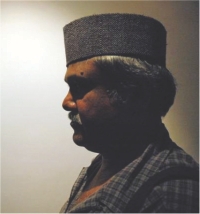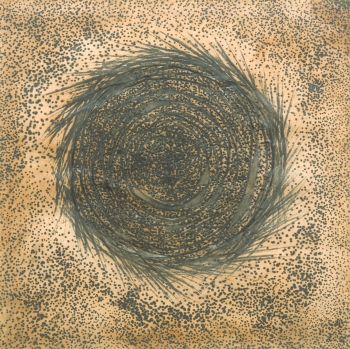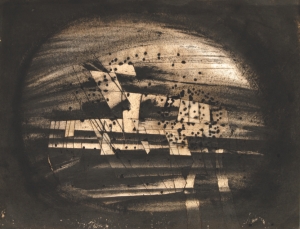| Home - Back Issues - The Team - Contact Us |
 |
| Volume 11 |Issue 29| July 20, 2012 | |
|
|
Remembrance
Symphony in Black and White Fayza Haq
It is strange to see the unseen works of a dear friend who has left the world. Yet the exhibition organised by Alliance Francaise titled 'Shadows and Light' as a tribute to the artist certainly demonstrates the great promise he had, but did not get a chance to explore further. Fokhrul Islam, indeed was that artiste who would have drawn more attention for his unique style had his life not been cut short on April 6 of this year. Not that he hadn't already received a lot of praise both at home and abroad. In Italy his works caught the eye of well known artists Raffaele Grossi as well as Patrizia Guiotto, Del Guidice and Petra Wiess who all admired Fokhrul's extraoordinary sensitivity and richness as well as his ability to bring all this with just a single colour. The artist did not have a fixed time for his work: “I have my moods and drives and follow them, whatever the time of the day. I work with press ink, mustard oil and soya bean oil on paper. I like black and white because they surpass all colours and express my feelings of nostalgia and memories in the least complicated way. I've brought in landscapes with broken houses, crumbling old walls, windows, arches and pillars. When I toured Italy and India, I saw a lot of remnants of old, decaying and crumbling buildings that spoke of the past civilisations, and I tried to capture them in my lines, curves, dashes and swirls. I have brought in temples, churches, houses and halls that are crumbling and speak of a glorious past." He had added that when he dealt with the ball and the plank of wood he would show life when it is in balance and out of balance. His work also reflected the tensions in life and nature. Fokhrul studied for two years in Beijing, China, and under various foreign visiting teachers in Dhaka such as Susan Benton from US, Adreana Hernandez from Denmark and H Gercke from Germany. He has exhibited in Japan and India and has an award from Goho, Japan. He impressed the Indian and other overseas collectors, with his power of dramatic and decisive lines in black, which are done with ink and pen. At the back of these lines, done with poise and perfection – as if he were some architect—contain the backdrop of mustard yellow. This was brought in by the inclusion of mustard oil. Print ink and mustard oil present his thought content and focus.
One has seen him drawing lines repeatedly on his sketch book, at the Cafe Varandha, Alliance Francaise in Dhanmandi. He was a loner, an introvert, who never bragged about his talents and always came up with original ideas and symbols, never being seduced into copying from books or magazines. He studied the world quietly and was always attracted to simplicity. The artist, in his typical minimalist way, has depicted the ambiance of Bangladesh, with its floods and famines, and its pell-mell jerry buildings in the cosmopolitan city of Dhaka – with possible escapes in the villages – or in flights of fancy. The artist's power and energy have won him accolades from "Art Heritage" India, Pakistan and India. Critiques have said that the "celebration of the richness" of Fokhrul's thoughts, lend one courage and fortitude. It helps one to escape from the pervading life of the twenty-first century – the world over i.e. The artist aids the viewer to lead his/her life with "courage and dignity". His cityscapes and nightscapes present denials and hopes — in a dramatic, daring way. The artist' paintings in the present exhibition have been carefully selected from innumerable collection of all his paintings on boards. Throughout his essays, his focus and themes remain both on the developed and the developing world. The artist has been well aware of poverty and industrialisation. The artist has brought in optimism– even when he has various types of pollution and world heritage in mind. His vision would include the progress of mankind and he dreamt of a future of tranquility despite all the odds against such utopian ideas. The eye -relief has been included by leaving large masses of white in the backdrop and elsewhere, in his imaginative paintings. The boards that the artist has used has an up and down surface – which lends it grace and peace. He has pushed and stabbed his backdrop and frontal space. He has done this with the passion of a driven, creative person. The artist has brought in a decisive sense of belonging with his textures. There is pearl-like gleam where the print-ink has not seeped in.
One is not confused by the colour combinations and compositions of his images on the surfaces of his gleaming boards. By following Fokhrul's trail of thought, one gains hope to march on like brave individuals through the cloudy and sunny days. His aesthetics and sensibility is easy to see if one has the "time to stand and stare", and when one is not carried away by the recent rush of the past two centuries, to get ahead of the others. The artist mixes abstraction with figures; and thus combines the spirit and the body. Fokhrul's use of symbols has a positive meaning behind them. Fokhrul's exhibits, both at home and abroad, have been praised to the hilt and beyond. One is speechless with wonder with his inimitable geometrical precision in presenting seed bursts, spots, rips, splinters and gashes. These present romantic images – like moonlight skies, dark forests – along with high-rise urban buildings. His smudges and blotches bring in the "agony and ecstasy of life." Fokhrul, who had exhibited in India, Pakistan, Japan and Bangladesh, has been praised for his singular imagery and chromatic economy. He has used simply golden ochre and smoldering black on white. His work, at times, has appeared like water colour, as it dribbled, flowed down and staineds. With quick, sweeping strokes and lines, he would bring in large landscapes, vibrant with life, despite their simplicity and economy of colours. Speaking of his work, Fokhrul once remarked: “I'm not trying to prove my skill but am expressing my feelings, emotions and love in the simplest of ways. You cannot measure love or affection so I cannot pass judgment on my work. If my work touches your heart even in the slightest of way, it shall be my gain.”
|
||||||||||||
Copyright
(R) thedailystar.net 2012 |



